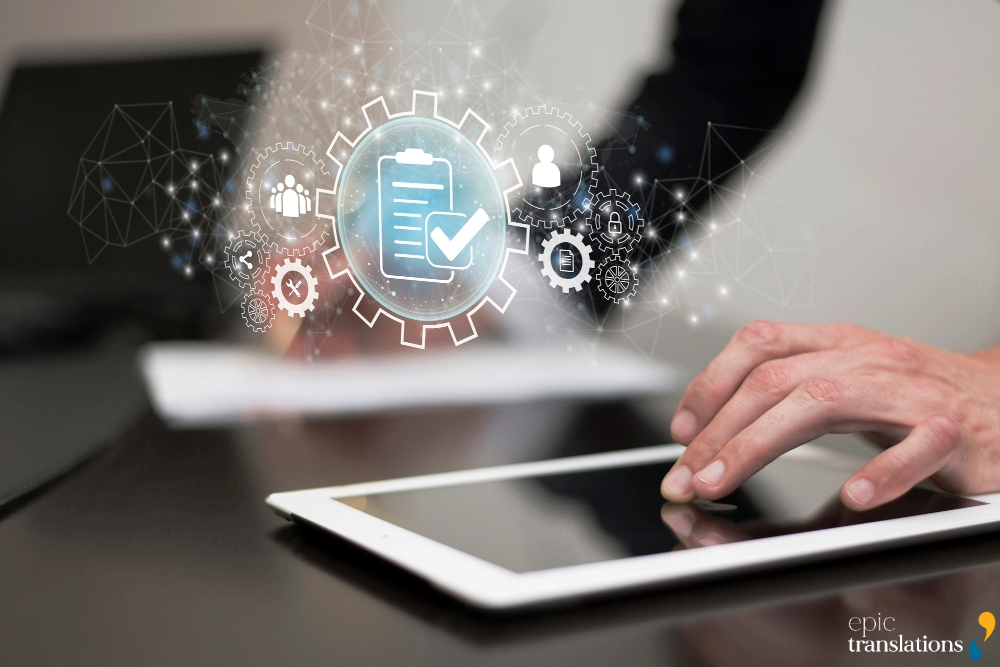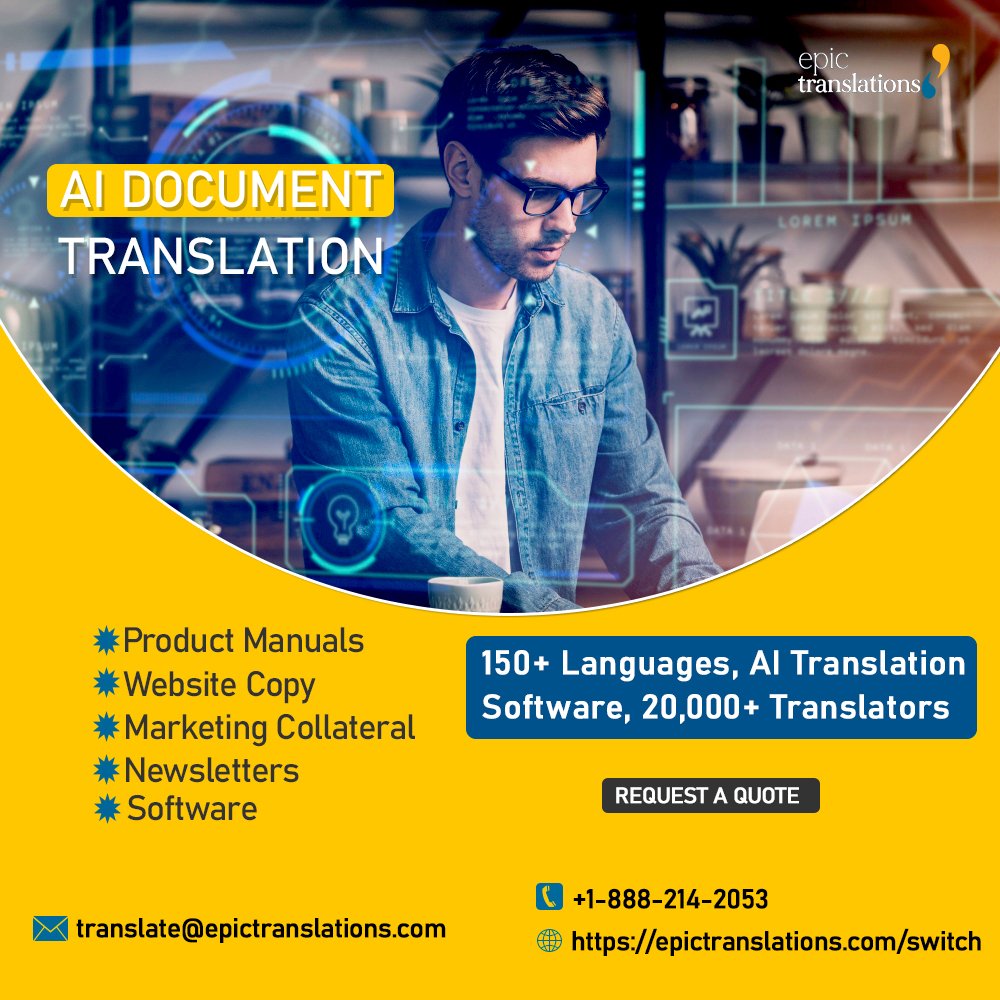
In today’s global economy, industrial automation equipment manufacturers face the challenge of entering diverse markets with complex regulations. A crucial part of this is ensuring technical documents are translated accurately and efficiently.
While human translators haven’t completely been replaced, document translation workflow has become easier and faster thanks to AI translation software. It is known to help manufacturers streamline communications between their global employees, suppliers, and customers.
The Importance of Document Translation in Industrial Automation
Industrial automation equipment manufacturers produce a wide range of complex products, including robotics, control systems, and automated machinery. These products often require extensive documentation, including user manuals, installation guides, maintenance instructions, and safety protocols. Investing in high-quality document translation is essential for maintaining competitiveness and fostering seamless global collaboration in the industrial automation sector. Accurate translation of these documents is crucial for several reasons:
1. Regulatory Compliance: For EU member countries and others, each nation has its own unique regulations and standards that manufacturers must adhere to. Accurate translations are essential to ensure that all documentation complies with these local laws, helping to prevent legal issues and fines down the road.
2. Safety and Usability: Misinterpretation of technical instructions can lead to equipment malfunction, accidents, or even severe injuries. Precise and professional translations ensure that users can correctly operate and maintain the equipment, enhancing safety and usability.
3. Customer Satisfaction: Providing documentation in the local language improves customer satisfaction by making the product more accessible and user-friendly. It also demonstrates a commitment to supporting customers in their native language, fostering trust and loyalty.
4. Market Expansion: Accurate translations enable manufacturers to enter new markets more efficiently. Clear and understandable documentation can be a decisive factor in gaining a competitive edge in international markets.

Traditional Translation Challenges
Historically, document translation (also known as ‘docu translate’) for industrial automation equipment has been a labor-intensive and time-consuming process. Relying on human translators, manufacturers faced several challenges:
1. Time-Consuming: Translating extensive technical documents manually is a slow process. This can delay product launches and updates, impacting time-to-market and competitive positioning.
2. Inconsistency: Maintaining consistency across multiple documents and languages is challenging. Human translators may interpret technical terms differently, leading to inconsistencies that can confuse end-users. Terminology files and translation memories addressed this issue for the most part. Even then there can be inconsistencies if multiple translators are involved in the process.
3. Cost: Hiring skilled translators, especially for specialized technical content, can be expensive. The costs escalate further when multiple languages are involved.
4. Error-Prone: Despite the best efforts, human error is inevitable. Even minor mistakes in technical translations can have significant repercussions, potentially compromising safety and functionality.
The Emergence of AI Translators
AI document translation software has revolutionized the field of professional translation services. Leveraging machine learning and natural language processing (NLP) technologies, AI translators offer several advantages over traditional methods:
1. Speed and Efficiency: AI translators can process large volumes of text quickly, significantly reducing translation times. This enables manufacturers to accelerate product launches and updates, maintaining a competitive edge.
2. Consistency and Accuracy: AI language translators maintain consistency across documents by adhering to predefined terminologies and translation rules. Advanced algorithms ensure high accuracy, minimizing the risk of errors.
3. Cost-Effective: By automating the translation process, AI translators reduce the need for human intervention, leading to cost savings. Manufacturers can translate documents into multiple languages without incurring prohibitive expenses.
4. Scalability: AI translation software can easily accommodate increasing volumes of documentation. This scalability is particularly beneficial for manufacturers with diverse product lines and global operations.

Key Features of AI Translators
To fully appreciate the use of AI for translation, it’s essential to understand the key features that make AI translators effective:
1. Machine Learning Algorithms: AI document translation software uses machine learning algorithms to analyze vast amounts of text. These algorithms learn from existing translations, improving their accuracy and efficiency over time.
2. Natural Language Processing (NLP): NLP enables AI translators to translate by understanding and interpreting human language. This includes recognizing context, syntax, and semantics, all crucial for accurate technical translations.
3. Glossary and Terminology Management: AI document translation software can store and manage specialized glossaries and terminologies. This ensures consistent use of technical terms across all documents, enhancing clarity and precision.
4. Real-Time Translation: AI translation software offers real-time translation capabilities, allowing manufacturers to quickly translate updates and modifications. This is particularly useful for dynamic documentation that frequently changes.
5. Integration with Existing Systems: AI translators can integrate with content management systems (CMS), enterprise resource planning (ERP) systems, and other digital tools. This seamless integration streamlines the translation workflow and enhances overall efficiency.
COMING SOON :: AI Translation Hub from EPIC Translations. Seamlessly translate your content directly from our site or implement it into your own environment for unparalleled accuracy and efficiency. Stay tuned for more updates!

Case Studies and Real-World Applications
Several industrial automation equipment manufacturers have successfully implemented AI for translation, achieving remarkable results. Here are a few case studies:
1. Global Robotics Manufacturer: A leading robotics manufacturer leveraged AI document translation capabilities to translate user manuals and maintenance guides into 15 languages. The AI-powered solution reduced translation time by 50%, improved accuracy, and significantly lowered costs. As a result, the company was able to enter new markets more quickly and effectively.
2. Automated Machinery Producer: An automated machinery producer used AI translators to ensure regulatory compliance in multiple countries. By accurately translating safety protocols and installation instructions, the company avoided legal issues and enhanced the safety of its products. Customer feedback highlighted the improved clarity and usability of the documentation.
3. Control Systems Provider: A control systems provider integrated AI for translation with its content management system, streamlining the translation process for its extensive product documentation. The real-time translation feature enabled the company to promptly update documents in response to customer feedback and regulatory changes, improving customer satisfaction and compliance.
Future Prospects and Innovations
The role of AI for document translation for industrial automation equipment manufacturers is continually evolving. Future innovations are likely to further enhance the capabilities and benefit:
1. Enhanced Language Models: Ongoing advancements in language models will improve the accuracy and fluency of AI translations. These models will better understand complex technical terminology and context, delivering even more precise translations.
2. Multimodal Translation: Future AI for translation may incorporate multimodal translation capabilities, enabling the translation of not only text but also diagrams, charts, and images. This will provide a more comprehensive professional translation solution for complex technical documents.
3. Voice and Speech Recognition: AI document translation integrates voice and speech recognition technologies to handle spoken instructions and documentation. This will be particularly useful for training materials and interactive user guides.
4. Continuous Learning and Adaptation: AI document translation software will continue to learn and adapt based on user feedback and new text. This continuous improvement will ensure that translations remain accurate and relevant in an ever-changing industry landscape.
Conclusion
AI for translation is transforming the way industrial automation equipment manufacturers manage their document translation needs. By offering speed, accuracy, consistency, and cost-effectiveness, AI document translation software and services enable manufacturers to overcome traditional translation challenges and achieve their global expansion goals. As AI technology continues to evolve, the future of AI translation in the industrial automation sector looks promising, paving the way for safer, more efficient, and more accessible products worldwide.
Start Your Journey with EPIC Translations
At EPIC Translations, we specialize in AI translations for industrial automation equipment manufacturers. Our 20,000 plus AI translators ensure seamless multilingual communication with your global stakeholders.
We are dedicated to sharing your message with the world. Whether you need translations for product manuals, company newsletters, app/website content, or legal documents, our professional translation services bridge language barriers economically with our AI translation software. Without compromising quality.
Start your journey with EPIC Translations today and experience the power of our document translation services helping you erase language barriers. Take a moment to watch a brief video showcasing our upcoming AI translation software!
Ready to elevate your upcoming document translation project with our cutting-edge AI translation software? Get started now by filling out the form below, and we’ll get back to you promptly with a personalized quote. Prefer a direct conversation? Give us a call at (888) 214-2053. We’re excited to assist you in achieving seamless multilingual communication!
